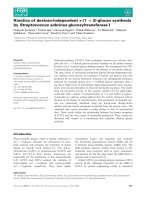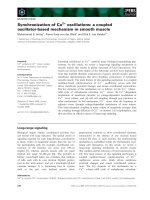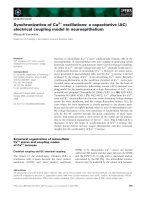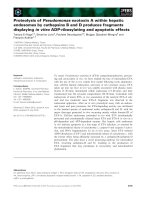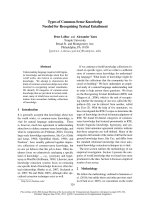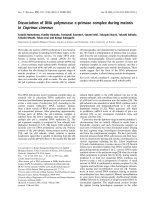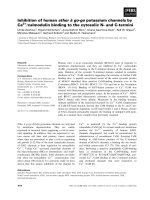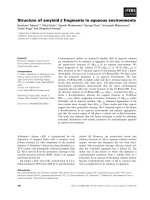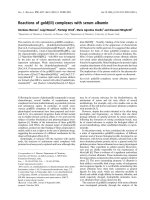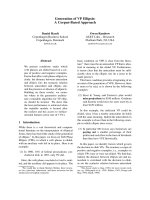Báo cáo khoa học: "USES OF C-GP.APHSlil A PROTOTYPE FOR TRANSLATION" docx
Bạn đang xem bản rút gọn của tài liệu. Xem và tải ngay bản đầy đủ của tài liệu tại đây (266.25 KB, 4 trang )
USES OF C-GP.APHS
lil
A PROTOTYPE FOR ALrFC~ATIC TRNLSLATION,
Marco A. CLEMENTE-SALAZAR
Centro de Graduados e Investigaci6n,
Instltuto Tecnol6gico de Chihuahua,
Av. Tecnol6gico No. 2909,
31310 Chihuahua, Chih., MEXICO.
ABSTRACT
This paper presents a prototype, not com-
pletely operational, that is intended to use
c-graphs in the translation of assemblers. Firstly,
the formalization of the structure and its princi-
pal notions (substructures, classes of substruc-
tures, order, etc.) are presented. Next section de-
scribes the prototype which is based on a Transfor-
mational System as well as on a rewriting system of
c-graphs which constitutes the nodes of the Trans-
formational System. The following part discusses a
set of operations on the structure. Finally, the
implementation in its present state is shown.
1. INTRODUCTION.
In the past [10,11], several kinds of repre-
sentation have been used (strings, labelled trees,
trees with "decorations", graphs of strings and
(semantic) networks). C-graphs had its origin as
an alternative in the representation and in the
treatment of ambiguities in Automatic Translation.
In earlier papers [4,5] this structure is named
E-graph but c-graph is better suited since it is a
generalized "grafo de cadenas" (graph of strings).
This structure combines some advantages of
the Q-systems [7] and of the trees of ARIANE-78
[1,2,11], in particular, the use of only one struc-
ture for all the translation process (asln the
former) and foreseeable decidability and parallel-
ism (as in the latter). This paper presents a pro-
totype, not completely operational, that uses
c-graphs and is intended to translate assemblers
to refine the adequacy of this kind of structure
in the translation of natural languages.
2. DEFINITIONS
C-graph. A c-graph G is a cycle free,labelled
graph [1,9] without isolated nodes and with exactly
one entry node and one exit node. It is completely
determined by a 7-tupie: G=(A,S,p,I,O,E,¢), where
A is a set of arcs, S a set of nodes, p a mapping
of A into SxS, I the input node, 0 the output node,
E a set of labels (c-trees, c-graphs) and E a map-
ping of A into E. For the sake of simplicity, arcs
and labels will be merged in the representation of
G (cf. Fig.1 . Interesting c-graphs are sequential
c-graphs (cf. Fig.2a) and bundles (cf. Fig.2b).
G= 1~7
h~ ~ e v k
A={1 12} ; S={1 7} ; I={1} ; 0={7}
p={ (1,1,2), (2,2,4), (3,4,5),
(4,5,7), (5,5,6),
(6,6,7), (7,6,7), (8,2,3), (9,3,4), (10,3,5),
(11,1,2), (12,1,2)}
E={a,b,c,d,e,f,g,h,i ,j,k}
E={ (I ,a), (2,b), (3,f), (4,g), (5, i), (6,j),
(7,k), (8,c), (9,d), (lO,e), (11,b), (12,h) }
Fig.1. A c-graph.
GI= ~ i
:c
J ~o
(a)
(b)
Fig.2. A seq. c-graph (a) and a bundle (b).
C-trees. A c-tree or a tree with decorations
is an ordered tree, with nodes labelled by a label
and a decoration that is itself a decorated tree,
possibly empty.
Classes of c-graphs. There are three major
classes: (1) recursive c-graphs (cf. Fig.3a) where
each arc is labelled by a c-graph; (2) simple
c-graphs (cf. Fig.l) where each arc is labelled by
a c-tree and (3) regular c-graphs, a proper sub-
class of the second that is obtained by concatena-
tion and alternation of simple arcs (cf. Fig.3b).
By denoting concatenation by "." and alternation
by "+", we have an evident linear representation.
For example, G4=g+i.(j+k). Note that not every
c-graph may be obtained by these operations, e.g.G.
Substructures. For the sake of homogeneity,
the only substructures allowed are those that are
themselves c-graphs. They will be called sub-
61
-c-graphs or seg's. For example, G1 and G2 are
seg's of G.
G2
a) A recursive c-graph.
b)
A
regular c-graph.
G4=
Fig.3. Two classes of c-graphs.
Isolatability. It is a feature that deter-
mines, for each c-graph G, several classes of seg's
An isolated seg G' is intuitively a seg that has no
arcs that "enter" or that "leave" G'. Depending on
the relation that each isolated seg keeps with the
rest of the c-graph, several classes of isolatabil-
ity can be defined.
a) Weak isolatability. A seg G' of G is weakly
isolatable (segif) if and only if for every
node x of G' (except I' and 0'), all of the
arcs that leave or enter x are in G ~. E.g.:
G5=i is a segif of G.
b) Normal isolatability. A seg G' of G is normaly
isolatable (segmi) if and only if it is a
segif and there is a path, not in G', such
that it leaves I' and enters 0'. Example: G6=k
is a segmi of
G.
c) Strong isolatability. A seg G' of G is
strongly isolatable (segfi) if and only if the
only node that has entering arcs not in G' is
I' and the only node that has leaving arcs not
in G' is 0'. When G' is not an arc and there
is no segfi contained strictly in G', then G'
is an "elementary segfi"; if G contains no
segfi, then G. is elementary. E.g. G4 is a
segfi of G.
Order and roads. Two order relations are con-
sidered: (l) a "vertical" order or linear order of
the arcs having the same initial node and (2) a
"horizontal" order or partial order between two
arcs on the same path. A road is a path from I to 0
Vertical order induces a linear order on roads.
3. DEFINITION OF THE PROTOTYPE.
The prototype consists of a model and a data
structure. The model is essentially a generaliza-
tion of a Transformational System (TS) analogous
to ROBRA [2] and whose grammars are rewriting sys-
tems of c-graphs (RSC) [4,5,6]. Regarding data
structure, we use c-graphs,
3.1A Transformational ~stem.
This TS is a c-graph-~c-graph transducer. It
is a "control" graph whose nodes are RSC and the
arcs are labelled by conditions.
A TS is a cycle free oriented graph, with
only one input and such that,
CI) Each node is labelled with a RSC or &nul.
(2) &nul has no successor.
(3) Each grammar of the RSC has a transition
scheme S or c (empty scheme).
~4) Arcs of the same initial node are ordered.
TS works heuristically. G~ven a c-graph gn as
an input, it searches for the first path endin~ in
&nul. This fact implies that all of the transition
schemes on the path were satisfied. Any scheme not
satisfied provokes a search of a new path. For
example, if $1 is satisfied, TS produces Gl(gn)=g 1
and it proceeds to calculate G2(G1(go))=g ~. IY S 4'
is satisfied the system stops and produce~ g~.
Otherwise, it backtracks to GI and tests S2 If it
is satisfied g] is produced. Otherwise, it tests
S3, etc.
•
Snul
S 4
~- &nul
Fig.4. A Transformational System.
3.2 A REWRITING SYSTEM.
Let us consider a simple example: let GR be
the following grar~mar for syntactic analysis (with-
out intending an example of linguistic value).
R1:(g1+e1+g2)(g3+~2+g4)*
I
(g1+gZ)(g3+~2+g4)÷61
I
R2:(g1+~1+gZ)(g3+eZ+g4)
(gl+g2)(g3+~2+g4)+81
R3:~I(gl+~Z+g2)
~1(g1+g2)+B1
R4:~l(g1+~2+g2)
g1+g2+81
R5:(g1+~1+g2)(g3+~2+g4)
(g1+g2)(g3+~2+g4)+B1
R6:(g1+~1+g2)(g3+~2+g4)
(g1+g2)(g3+~2+g4)+61
~I=GN, ~2=GV / ==
81:=PHRA(~I,~2) /.
/ ~I=VB, ~2=GN / ==
/ BI:=PRED(~I,~2) /.
/ ~I=NP, ~2=AD / ==
/ BI:=GN(~I,~2)
/.
/ ~I=NP, ~2=PRED / ==
/ 61:=PHRA(~I,~2) /.
/ ~I=PRON, ~2=VB / ==
/ 61:=GV(~I,~2) /.
/ ~I=ART, ~2=NM / ==
/ BI:=GN(~I,~2) /.
As we can see, each rule has: a name (RI,R2,
), a left side and a right side.
The left side defines the geometricaI Form
62
and the condition that an actual seg must meet in
order to be transformed. It is a c-graph scheme
composed of two parts: the structural descriptor
that defines the geometrical form and the condition
(between slashes) that tests label information. The
first part use "*" as an "element of structural de-
scription" in the first rule. It denotes the fact
that no seg must be right-concatenated to g3+~2+g4.
The right side defines the transformation to
be done. It consists of a structural descriptor,
similar to the one on the left side and a llst of
label assignments (also between slashes) where for
each new iabe] we precise the values it takes; and
for each old one, its possible modifications. A
point ends the rule. Note the properties of an
empty g: if g' is any c-graph, then g.g'=g and
g+g'=g'.
Let us analyze the phrase: "Ana lista la ti-
ra". The representation in our formalism is G7.
Morphological analysis produces G8. Note that a11
ambiguities are kept in the same structure in the
form of para]]e] arcs. The application of GR to G8
results in Gg, where each arc will be labelled with
a c-tree with a possib]e interpretation of G8 in
grammar GR. The sequence of applications is R3, R6,
RS, RI, R2, R4. The system stops when. no more rules
are applicab]e.
G7= e Ana ^ lista _ la _^ tira :o
GS=
Ana
C
np
el
1 isto \
ad
t i
tar
lo
pron
, where
AI=PHRA(GN(NP(Ana),
AD(listo)),
GV(PRON(Io),
VB(tirar)))
A2=PHRA(NP(Ana), PRED(VB(IIstar, GN(ART(eI),
NM(tira))))
Operations are divided in two classes: (1)
those where the structure is taken as a whole (glo~
a]) and (2) those that transform substructures
(local),
I. Global Operations.
Concatenation and alternation have been de-
fined above. These operations produce sequentlaI
c-graphs and bundles respectively, as well as the
polynomia] writing of regular c-graphs.
Expansion. This operation produces a bundle
exp(G) from all the roads of a c-graph G. For exam-
ple, expansion of GIO produces exp(G10)=(b.f)+
(c.d.f)+(c.e).
GIO=
~ f
exp(G10)=
f
Fig.6. Expansion of a c-graph.
Factorization. There are two kinds and their
results may differ. Consider G11=a.b+a.c+d.e+d.f+
g.f+h.e. Left factorlzation produces G12=a.(b+c)+
d.(e+f)+g.f+h.e, and right factorization G13=a.b+
a. c+ (d+h). e+ (d+g). f.
Arborization. This operation constructs a
c-tree from a c-graph. There may be several kinds
of c-trees that can be constructed but we search
for a tree that keeps vertical and horizontal or-
ders, i.e. one that codes the structure of the
c-graph. An "and-or" (y-o) tree is well suited for
this purpose. The result of the operation will be
a c-graph with one and only one arc labelled by
the and-or tree. For example, arb(G)=G14 (cf. Fig.
7). Note that the non-regular seg has ~ as a root.
Regular seg's have o.
G14= C ~ :O , where
A= y (o (y (a) ,y (b) ,y (h)) ,a (y (b,f) ,y (c,d, f),
y (c,e)),o(g,y (i ,o(j ,k)))
Fig.7. Arborization of G.
Fig.5. Example of sentence analysis.
3.3 Operations.
2. Local Operations.
Replacement. Given two c-graphs G and G",this
operation substitutes a seg G' in G for G", e.g.
if G=G4, G"=m+n and G'=i, then the result will be
63
G
15=g+
(re+n) : (j+k).
Addition. This operation inserts a c-graph G'
into another, G, by merging two distinct nodes (x,
y) of G with the input and output of G'. Addition
requires only that insertion does not produce cy-
cles. Note that if (I,0) are taken as a couple of
nodes, we have alternation. Example, let (2,3) be
a couple of nodes of G16 and take G'=G17=s+u. The
resulting c-graph is G18.
c
G16=c c
i 2
3 5
c
GI8=
c
i
2
Fig.8. Addition of a c-graph.
Erasing. This eliminates a substructure G'
of a c-graph G. Erasing may destroy the structure
even if we work with isolated seg's. Consequently,
it is only defined on particular classes of seg's,
namely segfi's and segmi's. For any other substruc-
ture, we eliminate the smaller segmi that contains
it. A special case constitutes a segfi G' such
that I and 0 do not belong to G'. Eliminating G' in
such a case produces two non-connecting nodes in
the c-graph that we have chosen to merge to pre-
serve homogeneity. Example: let us take G and G'=
GIO, then the result of erasing GIO from G is G19=
G2.G4.
4. IMPLEMENTATION.
A small system has been programmed in PROLOG
[4] (mainly operations) and in PASCAL (TS and RSC).
For the first approach, we chose regular c-graphs
to work with, since there is always a string to
represent a c-graph of this class.
In its present state, the system has two
parts: (1) the Transformational System including
the rewriting system and (2) the set of local and
global operations.
The TS is interactive. It consists of an
ana-
lyzer that verifies the structure of the TS given
as a console input and of the TS proper. As data
we have the console input and a segment composed of
transition schemes. There are no finer controls for
different modes of grammar execution.
Regarding operations and from a methodological
point of vlew, algorithms for c-graph treatment can
be divided in two classes: (I) the one where we
search for substructures and (2) the one where this
search is not needed. Obviously, local operations
belong to the first class, but among global opera-
tions, only concatenation, alternation and expan-
sion belong to the second one. Detailed description
of algorithms of this part Of ~he system can be
found in [4].
5. CONCLUSION.
Once we have an operational version of the
prototype, it is intended as a first approach to
proceed to the translation of assemblers of the
microprocessors available in our laboratory such
as INTEL's 8085 or 8080 and MOTOROLA's 6800.
6. REFERENCES.
I.[I] Boitet, Ch. UN ESSAI DE REPONSE A QUELQUES
QUESTIONS THEORIQUES ET PRATIQUES LIEES A LA TRA-
DUCTION AUTOMATIQUE. DEFINITION D'UN SYSTEME PROTO-
TYPE. Th~se d'Etat. Grenoble. Avril. 1976.
2.[2] Boitet, Ch. AUTOMATIC PRODUCTION OF CF AND CS
ANALYSERS USING A GENERAL TREE TRANSDUCER. Rapport
de recherche de l'Institut de Math~matiques Appli-
qu~es N°218. Grenoble. Novembre. 1979.
3.[4] Clemente-Salazar, M. ETUDES ET ALGORITHMES
LIES A UNE NOUVELLE STRUCTURE DE DONNEES EN T.A.:
LES E-GRAPHES. Th~se Dr-lng. Grenoble. Mai. 1982.
4.[5] Clemente-Salazar, M.
E-GRAPHS: AN INTERESTING
DATA STRUCTURE FOR M.T. Paper presented in COLING-
82. Prague. July. 1982.
5.[6] Clemente-Salazar, M. C-GRAPHS: A DATA STRUC-
TURE FOR AUTOMATED TRANSLATION. Paper presented in
the 26th International Midwest Symposium on Clr-
cuits and Systems. Puebla. Mexico. August. 1983.
6.[7] Colmerauer, A. LES SYSTEMES-Q. Universit~ de
Montreal.Publication Interne N°43. Septembre. 1970.
7.[9] Kuntzmann, J. THEORIE DES RESEAUX (GRAPHES).
Dunod. Paris. 1972.
8.[10] Vauquois, B. LA TRADUCTION AUTOMATIQUE A
GRENOBLE. Document de Linguistique Quantitative
N°24. Dunod. Paris. 1975.
9.[11] Vauquois, B. ASPECTS OF MECHANICAL TRANSLA-
TION IN 1979. Conference for Japan IBM Scientific
Program. Document du Groupe d'Etudes pour la Tra-
duction Automatique. Grenoble. July. 1979.
64
